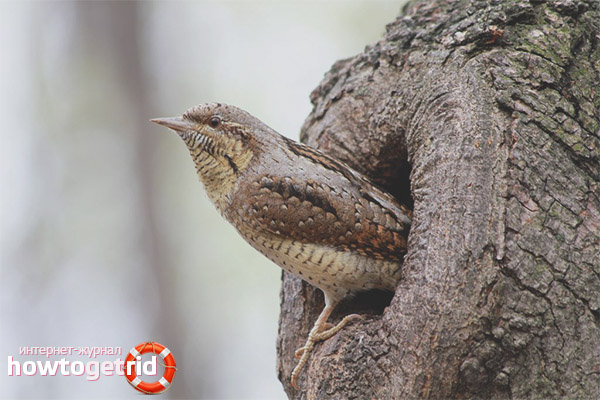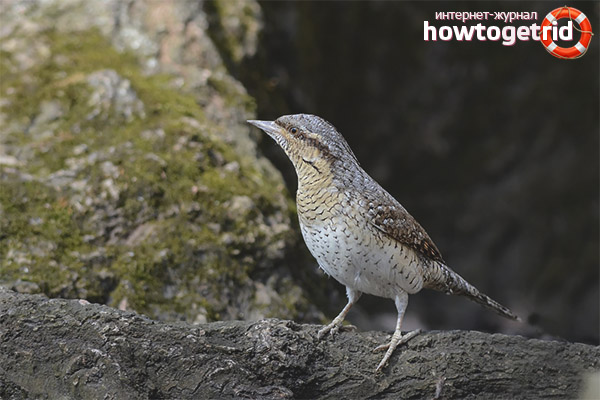The content of the article
Turrets call small birds that are directly related to the woodpecker family, they are well known in Eurasia and in Africa. Their characteristic feature is the disproportionate size of the head and a very long tongue, with the help of which these birds can extract insects from the tree trunk. They have a short beak and a long tail, not stiff.
Description
The body length of an adult reaches 20 centimeters, and its mass reaches 48 grams. The coloring of the plumage of a male and a female has practically no differences; it consists of camouflage tones that allow masking against the background of tree bark.
The back of the turntable has a motley color, dark spots are visible on an elongated gray-brown background, which in some individuals can stray together. On their abdomen, there is a whitish plumage having a transverse structure of the pattern. On the head of this bird there are characteristic black stripes, one starts at the beak and, passing through the eye, bends along the neck, and the second originates on the crown of the vertices and descends to the back of the head.
The front of the neck of this bird, as well as the area of the chest, is covered with plumage of an ocher or yellowish tone. Her eyes are dark brown, and the dull color of the paws and beak consists of a brownish tint. Young individuals are similar in color of plumage to adults, only the structure of the pattern of their outfit has more blurred shapes.
The spinner has a tail, which in appearance resembles the tail of a woodpecker, but its end is rounded and it does not differ in its rigidity, therefore it is not suitable as a support in flight.
Diet
In the warm season, when the turntables are busy breeding, the main food for them is various ants, for example, turf, earth yellow or forest red, and it can also be different types of lazius or formica. These birds are not so much interested in the ants themselves as their larvae or pupae. Of course, besides ants, birds are interested in any other insects that can be found on a tree. It can be aphids, various caterpillars or bugs, but the vertichy diet is not limited to insects alone, they definitely will not give up fruits or berries.
It is curious that during the search for food the turntables are guided by bright colors, because of which often not edible objects appear in their stomachs, they can easily bite with foil, bright color with plastic or non-ferrous metal shavings.
Habitat
On the African continent, birds of this species are widespread in Algeria and in Tunisia, in addition, they can be found on the shores of the Mediterranean Sea. In Eurasia, this bird can be found in the area of forests, from the coasts of the Iberian Peninsula and the western part of France to the eastern outskirts, the Kolyma channel, Sakhalin Island, the Kuril archipelago and Japan.
Of all the species of woodpeckers that live outside the territory of Europe, only the verticothorax is located for seasonal flights. And only some populations that choose the African continent as their habitat prefer to lead a sedentary lifestyle. Birds of this species, choosing spaces as their permanent habitats, located from the Mediterranean sea coasts to mountains located in the central part of Asia, migrate over short distances.All other turntables prefer long-distance seasonal flights.
Thus, in winter time, turntables can be found in many places of the African continent located south of the Sahara. They fly to Senegal and the Gambia, as well as to Sierra Leon and Ethiopia. In addition, they can be found in the Congo and Cameroon. Populations living in Siberia or in the regions of the Far East prefer to winter in India, as well as in the southeastern part of Asia.
When it comes time to build nests, turntables prefer to settle in sparse deciduous forests or plantings, and mixed areas of the forest may also arrange them. Birds are attracted by aspen, birch and linden, they are more suitable for forest glades, clearings or forest outskirts, forest belts located in the fields, or the coasts of water bodies can still be used.
Turntables are not at all embarrassed by their close proximity to humans, so they can often be seen on the territory of settlements, in various gardens, park areas and in areas of the private sector. They consider open steppe spaces unsuitable for habitation.
Offspring
Birds of this species create new pairs with each coming spring. From the warm regions where they spend the winter period, birds usually do not rush to return. In nesting places they can be noticed only by the end of April, beginning of May. For the nest, these birds are looking for secluded places in the form of cavities of rotten trees or thick branches, and an empty hollow can also come up, the main thing is that the location is not lower than 3 meters from the soil level.
The beak of the turntables is not distinguished by its power, so they cannot knock out the hollow on their own. Not infrequently, they manage to fall in love with suitable loopholes in the structures of utility rooms or summer cottages; a birdhouse may be a good solution for them. In a difficult situation, the code cannot be found for a suitable place for the nest for a long time, the turntables are able to dispute the place they like with other birds.
Smaller birds, such as gray flycatchers or redstart, often have to suffer from this predatory behavior of a vertically tail. But aggressive invaders sometimes become victims of eviction themselves, they can be replaced by motley, as well as Syrian woodpeckers.
Choosing a place to build a nest is the male’s privilege, he takes a responsible approach to solving this issue, and when the choice is made, he sits down nearby and with the help of his voice insists on calling his girlfriend until she appears. The arriving female evaluates the finding of her gentleman, after which mating occurs. With such cares as building nests, vertices do not burden themselves, the female lays her masonry simply in wood dust. In the best case, the nest left after the previous owners will be used.
A female turntable lays clutch from the last ten days of May to the first half of June, sometimes she manages to make two clutches per season. Usually it happens from 7 to 10 eggs, although in rare cases there may be 14, they are light in color almost white. If, as a result of tragic circumstances, the clutch is lost, the female has the ability to postpone it again.
The female lays her masonry one egg a day, and begins to hatch when the penultimate egg is laid, the incubation period is about 2 weeks. The female is mainly engaged in hatching eggs, but from time to time the male replaces her briefly. Little chicks are born in turn, they take a position, turning their beak to the center, creating a common figure in the form of a pyramid.
Singing features
This species of birds is engaged in singing only during the mating season, it resembles loud chirping, composed of high sounds. The male, having found a suitable hollow, settles down next to him and begins to call the female, making monotonous sounds repeating with great frequency, one trill can consist of 15-18 repetitions. A female arriving answers him in a similar way; in a duet they do not perform their mating song.
There are times when the male fails to shout to the female, once in this situation, he throws his find and retries elsewhere. In alarming cases, these birds express their concern with a quiet ticking or thin jerky food.
Video: turntable (Jynx torquilla)












Submit